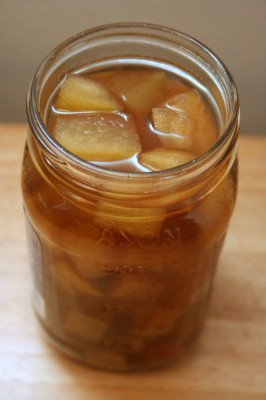It’s ironic that two ways of preserving food are also synonymous with “difficult.” If you’re in trouble, you’ll say you’re in a pickle or in a jam. Making pickles, however, is easy. My dad can’t boil pasta, but he can make pickled cucumbers and radishes with soy sauce and cilantro. Let vegetables sit in vinegar, salt and/or sugar, and you’ll have a snack to fall back on whenever you’re, er, in a pickle.
Since the summer brings a surplus of watermelon, I used leftover rind that would have gone to the trash. The rind is edible, as long as you peel off the tough skin. By itself, it’s akin to cucumber.
There’s several methods for pickling watermelon rind, some which call for buckets of salt. I chose a vintage Joy of Cooking recipe, because it has sugar instead. The finished product resembles extra crisp, tart apple pie filling. It’s great by itself, but it can also accompany yogurt, ice cream, pancakes, pork chops and hot dogs (finely mince the pickles to make a sweet relish). It’s so good that you might want to buy watermelon just to use up the rind.
Canning and preserving gets a difficult rap because most recipes call for sterilizing the jars and creating a vacuum seal. I use ordinary glass jars and don’t worry about removing the air. The acid, sugar and salt act as natural preservatives, as long as the pickles are left in the refrigerator.
This recipe may be my cheapest one yet. The watermelon rind is essentially free and so is the recipe (I found the book on a giveaway shelf).
Sweet Pickled Watermelon Rind
Adapted from The Joy of Cooking Standard Edition (1973) [2]
Makes about 5 quarts
Rind of 1 large watermelon, about 5 quarts
7 cups sugar
2 cups apple cider vinegar
1/4 tsp cloves
1 tsp cinnamon
- Cut the watermelon rind in strips before peeling. Remove the green skin and pink flesh. Dice into one-inch cubes.
- In a large pot of boiling water, parblanch the rind for about five minutes, or until it can be pierced with a fork. Do not overcook. Drain and set aside in a large bowl.
- Bring the sugar, vinegar, cloves and cinnamon just to a boil. Pour the syrup over the rind, making sure the rind is covered. Let stand overnight.
- Strain out the syrup into a large pot and reboil. Pour the syrup over the rind. Let stand overnight as before.
- On the third day, sterilize several glass jars and lids by boiling them for 15 minutes. Arrange the jars sideways, allowing the water to flow in. Using tongs, remove the jars and lids. Allow to air dry on clean paper or cloth towels.
- Pack the rind into the jars. Boil the syrup again and pour over the rind till overflowing. Seal and store in the fridge.
